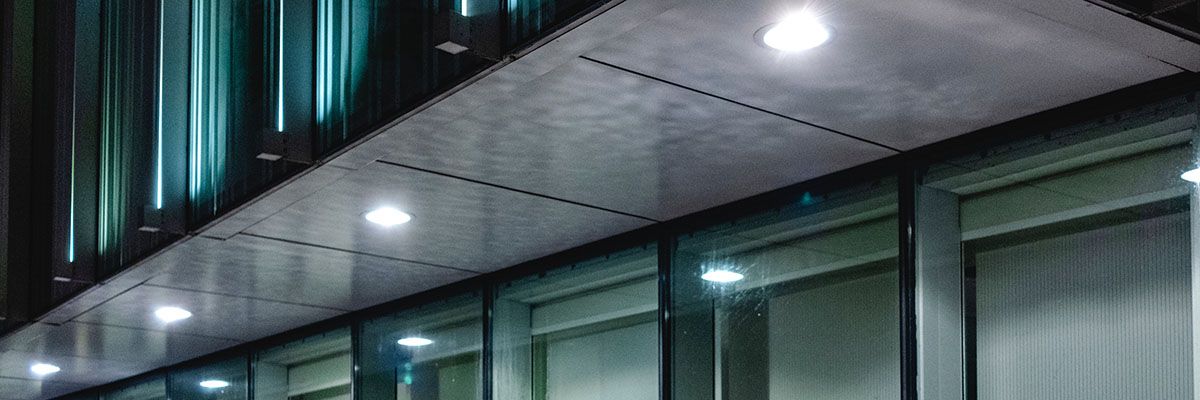
Lighting testing and analysis consulting
Switch on, switch off, save electricity, economize. Well, that might be every man’s view of lighting. Still, the domain of lighting, particularly within a larger or commercial facility, isn’t as simple as that because testing and analysis and likely consulting should come first.
Lighting plans and lumen testing, dimming procedures and lighting types, light pollution and more are just a few aspects that make up what is a complex equation. In this blog, we’ll try to explain the subject of lighting in a little more detail and, once we’ve done that, discuss how – if you’re a facility manager – you can optimize its performance.
About lighting: the basics
Far from being plug-and-play, achieving functional, cost-effective lighting involves a balancing act. The three aspects to balance are natural lighting, electrical lighting, and lighting control systems, all of which must work harmoniously to deliver an optimal result.
While that sounds reasonably simple in theory, it’s less so in practice. Think about it this way: we all want to light our facilities efficiently and cost-effectively, but the truth is, most of us need to learn how because we’re not lighting experts. For instance, how much do you know about:
- Effectively balancing natural and electric lighting.
- Implementing energy-efficient systems.
- Deploying integrated lighting controls.
For most of us, the likely answer is “not a lot.” But we need to, not least because lighting should be an integral part of a building’s design and then actively support tenants’ business activities. We’ll come back to this question later when we look at solutions, but for now, let’s continue to look at the challenge in more detail.
Lighting considerations
Breaking down lighting questions into more detail, what are some of the issues that facility managers need to consider to formulate an effective lighting plan? Here are five:
System selection
Do you have an over-arching lighting strategy, (particularly relevant if you have a new building or space)? For instance, do you have a methodical approach to integrating electric lighting with daylight? How will you select your system, considering factors like light sources, lighting itself, and control systems? How will you prioritize flexibility, suitability, cost, energy efficiency, and ease of use?
Assessment
Are you on top of your current approach to lighting? Are you measuring its effectiveness, considering asset-related issues like glare, and taking countermeasures where problems are identified? Are you using lighting in a way that’s best suited to activities (for instance, lighting appropriate for areas of screen use)? Do you have a mechanism in place (surveys, for example) to evaluate your lighting investment on an ongoing basis?
Managing daylight
How much consideration are you giving to daylight? Have you considered window design , has daylight been properly measured, and have you thought about shading to reduce solar heating and glare? What about issues like over-shadowing, access to daylight, and others? Like everything else, daylight is there to be optimized.
Progressive lighting
Lighting has health effects, which should also be considered as part of your lighting plan. Daylight (above) comes into play here, as do systems like circadian electric lighting, which is “human centric.” There’s a lot of research in this field, as well as codes and standards to be met. Are you keeping up?
Pollution
Lighting, particularly in commercial facilities, can result in unwanted light spill into other properties, or simply lighting up the sky at night. Are you aware of your facilities impact in this area, and have you taken steps to resolve any problems? Do you have an environmental statement within your facilities documentation?
Formulating a plan
In simple terms, the question of lighting is easy to take for granted, but approaching lighting issues without a strategy can create as many problems as it solves.
The best way to understand your situation and identify areas for improvement is generally working with an expert consultant. This is a one-off, albeit repeatable at suitable intervals, investment that allows you to evaluate your situation and identify areas where remedial action would be beneficial.
A consultant can, for instance:
- Help you develop a lighting plan, optimizing when lights are turned on and off based on a formal schedule. This has obvious benefits in terms of both lighting performance and cost savings.
- Base your lighting choices (for instance, spotlight vs. track lighting) on standard lumen testing rather than guesswork, so you can be sure your requirements are met most effectively .
- Facilities change over time, for instance, as a result of maintenance or re-configuration. Lighting needs to keep up so peak optimization is maintained. Here, a managed service may be the answer, but expert-led reviews should be undertaken on a regular basis to see if needs have changed.
- Is your lighting functioning properly? Certain types of lighting, for instance, dimming, are often implemented incorrectly and don’t function to deliver maximum value as a result. Are you keeping track of how your solutions are performing and tweaking them as required?
Get on top of your lighting: the NexRev advantage
The takeaway is, if you still need to do so, don’t imagine that managing and optimizing your lighting is an afterthought within the facilities manager’s task list. It requires an active approach and yields benefits when applying the right strategy . Consulting can be a crucial step in the right direction by identifying the correct lighting strategy and developing an effective maintenance plan. Our consulting team and services help you optimize lighting for the best results for your facilities, staff, and customers.
At NexRev, we’ve been unlocking the power of facility and energy management data with over half a million connected devices across North America. Our team of experts is focused on helping you deliver more with your budgets, infrastructure, and assets to create sustainable savings in operations and energy, reducing your risk and increasing operational confidence. To discuss further, please email us at